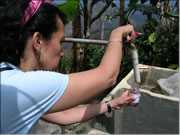Assessing Access to Water & Sanitation
On this Page
It is common for many international organizations to use access to safe drinking water and hygienic sanitation facilities as a measure for progress in the fight against poverty, disease, and death. It is also considered to be a human right, not a privilege, for every man, woman, and child to have access to these services. Even though progress has been made in the last decade to provide safe drinking water and sanitation to people throughout the world, there are still billions of people that lack access to these services every day.
Drinking Water Sources
 According to the World Health Organization and UNICEF, in 2010, 89% of the world’s population used drinking water from improved sources (54% from a piped connection in their dwelling, plot or yard, and 35% from other improved drinking water sources), leaving 780 million people lacking access to an improved source of water 1.
According to the World Health Organization and UNICEF, in 2010, 89% of the world’s population used drinking water from improved sources (54% from a piped connection in their dwelling, plot or yard, and 35% from other improved drinking water sources), leaving 780 million people lacking access to an improved source of water 1.
The world met the United Nations’ Millennium Development Goal (MDG) drinking water target to halve the proportion of people without sustainable access to safe drinking water by 2015 in 2010, 5 years ahead of schedule 1. More than 2 billion people gained access to improved water sources from 1990 to 2010. However if current trends continue, 605 million people will be without an improved drinking water source in 2015 1.
Access to safe drinking water is measured by the percentage of the population having access to and using improved drinking water sources.
Improved drinking water sources should, but do not always, provide safe drinking water, and include:
- Piped household water connection
- Public standpipe
- Borehole
- Protected dug well
- Protected spring
- Rainwater collection
Unimproved drinking water sources include:
- Unprotected dug well
- Unprotected spring
- Surface water (river, dam, lake, pond, stream, canal, irrigation channel)
- Vendor-provided water (cart with small tank/drum, tanker truck)
- Bottled water*
- Tanker truck water
* Bottled water is not considered improved due to limitations in the potential quantity, not quality, of the water.
Top of PageSanitation Facilities
According to the World Health Organization and UNICEF, in 2010, only 63% of the world’s population used improved sanitation facilities, with Sub-Saharan Africa and Southern Asia having only 30% and 41%, respectively 1. An estimated 2.5 billion people are still without improved sanitation. About 15% of the world’s population lives without ANY FORM of sanitation and practice open defecation 1.
Access to sanitation is measured by the percentage of the population with access and using improved sanitation facilities.
Improved sanitation facilities usually ensure separation of human excreta from human contact, and include:
- Flush or pour-flush toilet/latrine to:
- Piped sewer system
- Septic tank
- Pit latrine
- Ventilated improved pit (VIP) latrine
- Pit latrine with slab
- Composting toilet
Shared sanitation facilities are of an otherwise acceptable improved type of sanitation facility that is shared between two or more households. Shared facilities include public toilets.
Unimproved sanitation facilities do not ensure hygenic separation of human excreta from human contact and include:
- Pit latrine without a slab or platform
- Hanging latrine
- Bucket latrine
- Open defecation in fields, forests, bushes, bodies of water or other open spaces, or disposal of human feces with solid waste
- World Health Organization and UNICEF. Progress on Drinking Water and Sanitation: 2012 Update. United States: WHO/UNICEF Joint Monitoring Programme for Water Supply and Sanitation; 2012.
- Page last reviewed: October 31, 2012
- Page last updated: October 31, 2012
- Content source:


 ShareCompartir
ShareCompartir